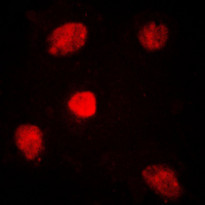ARG66895
anti-MED1 / TRAP220 antibody
anti-MED1 / TRAP220 antibody for ICC/IF,IHC-Formalin-fixed paraffin-embedded sections,Western blot and Human
Overview
| Product Description | Rabbit Polyclonal antibody recognizes MED1 / TRAP220 |
|---|---|
| Tested Reactivity | Hu |
| Tested Application | ICC/IF, IHC-P, WB |
| Host | Rabbit |
| Clonality | Polyclonal |
| Isotype | IgG |
| Target Name | MED1 / TRAP220 |
| Antigen Species | Human |
| Immunogen | KLH-conjugated synthetic peptide around the center region of Human MED1 / TRAP220. |
| Conjugation | Un-conjugated |
| Alternate Names | TR-interacting protein 2; TRIP-2; Mediator of RNA polymerase II transcription subunit 1; DRIP230; PPAR-binding protein; Vitamin D receptor-interacting protein complex component DRIP205; Peroxisome proliferator-activated receptor-binding protein; Trap220; DRIP205; CRSP1; TRAP220; PBP; p53 regulatory protein RB18A; CRSP200; Mediator complex subunit 1; Thyroid receptor-interacting protein 2; PPARBP; TRIP2; PPARGBP; ARC205; Thyroid hormone receptor-associated protein complex 220 kDa component; RB18A; Activator-recruited cofactor 205 kDa component |
Application Instructions
| Application Suggestion |
|
||||||||
|---|---|---|---|---|---|---|---|---|---|
| Application Note | IHC-P: Antigen Retrieval: Heat mediation was performed in Sodium citrate buffer (pH 6.0). * The dilutions indicate recommended starting dilutions and the optimal dilutions or concentrations should be determined by the scientist. |
||||||||
| Positive Control | H446 | ||||||||
| Observed Size | ~ 220 kDa |
Properties
| Form | Liquid |
|---|---|
| Purification | Affinity purification with immunogen. |
| Buffer | 0.42% Potassium phosphate (pH 7.3), 0.87% NaCl, 0.01% Sodium azide and 30% Glycerol. |
| Preservative | 0.01% Sodium azide |
| Stabilizer | 30% Glycerol |
| Storage Instruction | For continuous use, store undiluted antibody at 2-8°C for up to a week. For long-term storage, aliquot and store at -20°C. Storage in frost free freezers is not recommended. Avoid repeated freeze/thaw cycles. Suggest spin the vial prior to opening. The antibody solution should be gently mixed before use. |
| Note | For laboratory research only, not for drug, diagnostic or other use. |
Bioinformation
| Database Links |
Swiss-port # Q15648 Human Mediator of RNA polymerase II transcription subunit 1 |
|---|---|
| Gene Symbol | MED1 |
| Gene Full Name | mediator complex subunit 1 |
| Background | The activation of gene transcription is a multistep process that is triggered by factors that recognize transcriptional enhancer sites in DNA. These factors work with co-activators to direct transcriptional initiation by the RNA polymerase II apparatus. The protein encoded by this gene is a subunit of the CRSP (cofactor required for SP1 activation) complex, which, along with TFIID, is required for efficient activation by SP1. This protein is also a component of other multisubunit complexes e.g. thyroid hormone receptor-(TR-) associated proteins which interact with TR and facilitate TR function on DNA templates in conjunction with initiation factors and cofactors. It also regulates p53-dependent apoptosis and it is essential for adipogenesis. This protein is known to have the ability to self-oligomerize. [provided by RefSeq, Jul 2008] |
| Function | Component of the Mediator complex, a coactivator involved in the regulated transcription of nearly all RNA polymerase II-dependent genes. Mediator functions as a bridge to convey information from gene-specific regulatory proteins to the basal RNA polymerase II transcription machinery. Mediator is recruited to promoters by direct interactions with regulatory proteins and serves as a scaffold for the assembly of a functional preinitiation complex with RNA polymerase II and the general transcription factors (PubMed:10406464, PubMed:11867769, PubMed:12037571, PubMed:12218053, PubMed:12556447, PubMed:14636573, PubMed:15340084, PubMed:15471764, PubMed:15989967, PubMed:16574658, PubMed:9653119). Acts as a coactivator for GATA1-mediated transcriptional activation during erythroid differentiation of K562 erythroleukemia cells (PubMed:24245781). [UniProt] |
| Cellular Localization | Nucleus. Note=A subset of the protein may enter the nucleolus subsequent to phosphorylation by MAPK1 or MAPK3. [UniProt] |
| Calculated MW | 168 kDa |
| PTM | Phosphorylated by MAPK1 or MAPK3 during G2/M phase which may enhance protein stability and promote entry into the nucleolus. [UniProt] |
Images (3) Click the Picture to Zoom In
-
ARG66895 anti-MED1 / TRAP220 antibody ICC/IF image
Immunofluorescence: Formalin-fixed HUVEC cells were permeabilized with 0.1% Triton X-100 in TBS for 5-10 minutes and blocked with 3% BSA-PBS for 30 minutes at room temperature. Cells were stained with ARG66895 anti-MED1 / TRAP220 antibody (red) in 3% BSA-PBS and incubated overnight at 4°C.
-
ARG66895 anti-MED1 / TRAP220 antibody IHC-P image
Immunohistochemistry: Formalin-fixed and paraffin-embedded Human breast cancer tissue. Antigen Retrieval: Heat mediation was performed in Sodium citrate buffer (pH 6.0). The tissue section was stained with ARG66895 anti-MED1 / TRAP220 antibody at room temperature.
-
ARG66895 anti-MED1 / TRAP220 antibody WB image
Western blot: H446 whole cell lysate stained with ARG66895 anti-MED1 / TRAP220 antibody.








